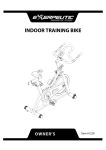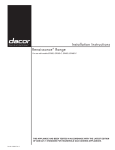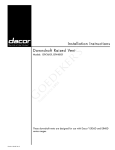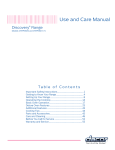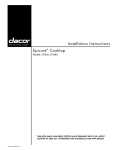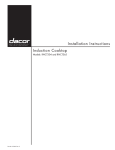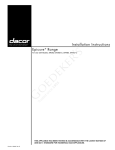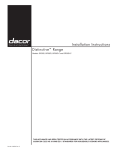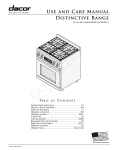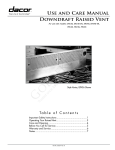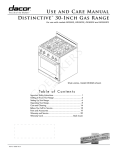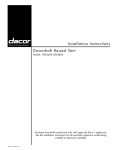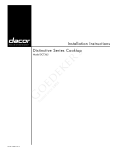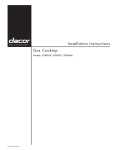Download Dacor DYRP48DS Specifications
Transcript
Installation Instructions Discover y ® Range Models: DYRP36DS, DYRP36D-C-S, DYRP48DS, DYRP48D-C-S THIS APPLIANCE HAS BEEN TESTED IN ACCORDANCE WITH THE LATEST EDITIONS OF ANSI Z21.1, UL858 AND UL60730-1, STANDARDS FOR HOUSEHOLD APPLIANCES. Part No. 108106 Rev. B Table of Contents Customer Service Information.....................................................II Important Safety Instructions...................................................... 1 General Safety Precautions......................................................... 2 Planning the Installation............................................................... 3 Electrical Requirements...............................................................3 Product Dimensions.....................................................................4 Gas Supply Requirements........................................................... 4 Cabinet Layout.............................................................................6 Installation Instructions................................................................7 Preparing for Installation.............................................................. 7 Electrical Connection.................................................................10 Gas Connection.........................................................................15 Final Installation.........................................................................16 Installing the Burner Knobs....................................................... 17 Cooktop Assembly.....................................................................18 Verifying Proper Operation........................................................ 19 Installation Checklist..................................................................19 IMPORTANT: • Installer: In the interest of safety and to minimize problems, read these installation instructions completely and carefully before you begin the installation process. Leave these installation instructions with the customer. • Customer: Keep these installation instructions for future reference and the local building inspector’s use. Customer Service Information If you have questions or problems with installation, contact your Dacor dealer or the Dacor Customer Service Team. For repairs to Dacor appliances under warranty call the Dacor Distinctive Service line. Whenever you call, have the model and serial number of the appliance ready. The serial number and rating labels are inside the grate, inside the door. Dacor Customer Service Team Phone: (800) 793-0093 ex. 2813 (U.S.A. and Canada) Monday — Friday 6:00 a.m. to 5:00 p.m. Pacific Time Web site: www.dacor.com Dacor Distinctive Service (for repairs under warranty only) Phone: (800) 793-0093 ex. 2822 (U.S.A. and Canada) Monday — Friday 6:00 a.m. to 5:00 p.m. Pacific Time Model Identification DYRP36D-C-S/NG/H SIZE (width in inches) CORD OPTION -C- = Appliance cord installed* No Character = Power cord not included GAS TYPE NG = Natural Gas LP = Liquid Petroleum (Propane) Model and serial number label located inside grill ALTITUDE H = Equipped for high altitude operation, 4000 ft. (1219 m) and up No Character = Equipped for low altitude operation * Mandatory configuration for freestanding units installed in Canada. Model and Serial Number Location All specifications subject to change without notice. No liability is assumed by Dacor® for changes to specifications. © 2014 Dacor, all rights reserved. Important Safety Instructions Important Information About Safety Instructions The Important Safety Instructions and warnings in this manual are not meant to cover all possible problems and conditions that can occur. Use common sense and caution when installing, maintaining or operating this or any other appliance. Always contact the Dacor Customer Service Team about problems and conditions that you do not understand. Safety Symbols and Labels DANGER WARNING WARNING – NEVER use this appliance as a space heater to heat or warm the room. Doing so may result in carbon monoxide poisoning and overheating of the appliance. WARNING NEVER cover any slots, holes or passages on the inside or outside of the range or cover an entire rack with materials such as aluminum foil. Doing so blocks air flow through the oven and may cause carbon monoxide poisoning. Aluminum foil linings may also trap heat, causing a fire hazard. Immediate hazards that WILL result in severe personal injury or death. WARNING Hazards or unsafe practices that COULD result in severe personal injury or death. CAUTION Hazards or unsafe practices that COULD result in minor personal injury or property damage. WARNING If the information in this manual is not followed exactly, a fire or explosion may result causing property damage, personal injury or death. -- Do not store or use gasoline or other flammable vapors and liquids in the vicinity of this or any other appliance. WARNING Tip-over hazard: • A child or adult can tip the range and be killed. • Attach the anti-tip bracket to the floor as directed in these installation instructions. • Engage the anti-tip bracket by sliding the anti-tip foot on the range into it according to these installation instructions. Using a flashlight, be sure that the anti-tip bracket engages the range’s anti-tip foot as shown below. • After moving the range, be sure to re-engage the anti-tip foot into the anti-tip bracket as shown below. • See the anti-tip bracket installation instructions in this guide for further details. • Failure to follow these instructions can result in death or serious burns to children or adults. -- WHAT TO DO IF YOU SMELL GAS • Do not try to light any appliance. • Do not use any phone in your building. • Immediately call your gas supplier from a neighbor’s phone. Follow the gas supplier’s instructions. • If you cannot reach your gas supplier, call the fire department. • Installation and service must be performed by a qualified installer, service agency or the gas supplier. -- Installation and service must be performed by a qualified installer, service agency or the gas supplier. Anti-tip bracket Anti-tip foot CALIFORNIA PROPOSITION 65 WARNING The burning of gas cooking fuel generates some by-products that are on the list of substances which are known by the State of California to cause cancer or reproductive harm. California law requires businesses to warn customers of potential exposure to such substances. To minimize exposure to these substances, always operate this unit according to the use and care manual, ensuring you provide good ventilation when cooking with gas. READ AND SAVE THESE INSTRUCTIONS 1 Important Safety Instructions WARNING • Read the accompanying use and care manual before operating this appliance. • Clean the cooktop thoroughly before operating it for the first time. • Keep packaging materials away from children. Plastic sheets and bags can cause suffocation. • • If you receive a damaged product, immediately contact your dealer or builder. Do not install or use a damaged appliance. Keep flammable items, such as paper, cardboard, plastic and cloth away from the burners and other hot surfaces. Do not place such items in the oven(s). Do not allow pot holders to touch hot surfaces or gas burners. • Do not wear loose or hanging apparel while using the range. Do not allow clothing to come into contact with the interior of the oven(s) or the cooktop and surrounding areas during and immediately after use. • To avoid a fire hazard, do not hang flammable or heat sensitive objects over the range. If the range is near a window, do not use long curtains as window treatment. The curtains could blow over the cooktop and create a fire hazard. • Do not use the oven(s) for storage. • Do not touch the outside surfaces of the range during the self-clean cycle. They will be hot. Venting from the oven may cause the cooktop and backguard to become hot. • Make sure that all the cooktop parts are dry before lighting a burner. • Turn the knobs to the “OFF” position prior to removing them from the valve stems. • The cooktop should never be operated without the knobs and trim rings in place. • For your safety, do not use the oven to cook without the convection filter installed. When the filter is not installed, the spinning fan blades at the back of the oven are exposed. • Non-stick coatings, when heated, can be harmful to birds. Remove birds to a separate, well-ventilated room during cooking. • To prevent damage, remove the meat probe from the oven(s) when it is not being used. • 2 WARNING This range must be properly installed and grounded by a qualified installer according to these installation instructions prior to use. The installer should show the customer the location of the gas shut off valve and the fuse or junction box so that they know where and how to turn off the gas supply and power to the range. • This appliance is not designed for installation in a mobile home or recreational vehicle. • Do not use this appliance in combination with a surface (countertop) ventilation system, air curtain or other type of range hood that directs airflow in a downward direction. • Do not install, repair or replace any part of the range unless specifically recommended in the literature accompanying it. A qualified service technician should perform all other service. • Do not connect this range to the gas supply without the supplied gas pressure regulator installed. • Before performing any type of service or installation, make sure the gas supply and power to the range are turned off. • NEVER block or cover any slots, holes or passages anywhere inside the oven or on the outside of the range or cover an oven rack with materials such as aluminum foil. Doing so blocks airflow through the oven and cooktop and may cause carbon monoxide poisoning or fire. See the Getting to Know Your Range section of the use and care manual for the location of the various air holes (slots). • Only use the range for cooking tasks expected of a home appliance as outlined in the literature accompanying it. This range is not intended for commercial use. • • DO NOT TOUCH THE SURFACES OF THE OVEN[S] OR COOKTOP DURING OR IMMEDIATELY AFTER USE. Do not line the oven(s) with aluminum foil or other materials. These items can melt or burn up during selfcleaning and cause permanent damage to the appliance. • • To avoid the possibility of fire, never leave this appliance unattended when the cooktop is in use. • Do not climb on any part of the appliance. Do not leave metal objects, such as aluminum foil, the meat probe, cookie sheets, etc. on the bottom of the oven(s). Objects left on the bottom of the oven could damage the bake element. In addition, the objects themselves could be damaged. • Do not leave children or pets alone or unattended in the area around the range. Do not allow children to play with the controls, pull on the handle(s), or touch other parts of the range. • • Do not store items of interest to children on top of or above the range. Children could be burned or injured while climbing on the appliance. On some ovens, the bake and broil elements are behind glass panels on the floor and ceiling of the oven chamber. Do not cover these glass panels with cookie sheets, aluminum foil, pots, pans, etc. Covering them could cause the heating elements to over-heat, damaging the oven. • Do not attempt to use this appliance in the event of a power failure. Planning the Installation WARNING IMPORTANT: Observe all governing codes and ordinances during planning and installation. Contact your local building department for further information. The appliance installation must be electrically grounded in accordance with local codes or, in the absence of local codes, with the National Electrical Code, ANSI/ NFPA 70: Electrical Requirements - All Model Numbers Except -C Models) • It is the owner’s responsibility to ensure that the electrical connection of this appliance is performed by a licensed electrician. • The correct voltage, frequency and amperage must be supplied to the appliance from a separate, grounded, circuit that is protected by a properly sized circuit breaker or time delay fuse. If a fuse is utilized, fuse both sides of the line (L1 and L2). Model Circuit Required Total Connected Load DYRP36DS 240 Vac*, 60 Hz, 30 Amp. 5.75 kW (24.0 Amp.) DYRP48DS 240 Vac*, 60 Hz, 50 Amp. 10.1 kW (41.9 Amp.) * 4-wire, two 120 Vac hot (L1 and L2), one neutral, one ground The ratings above are for reference only. Refer to the range data label for exact specifications (see inside cover for location). • The wiring needs to be long enough to allow the range to be pulled out for service, while remaining connected. • The wiring to the range must: ◊ Meet NEMA standards and have a minimum rating of 250 Volts @ 30 Amps for model DYRP36DS and 250 Volts @ 50 amps for model DYRP48DS ◊ Include a strain relief ◊ Be terminated by tinned leads, closed loop terminals or open ended spade lugs with upturned ends ◊ Connect to a junction box or receptacle installed by a licensed electrician The appliance may be connected one of the following ways: • Using conduit: ◊ A 4-wire conduit connected to a 4-wire junction box, or ◊ A 3-wire conduit (where local code permits, not for use with new branch circuit installations) connected to a 3-wire junction box. Suggested wiring color code: black, white, red and green. • Using an appliance cord: ◊ ◊ ◊ A 4-wire appliance cord equipped with a NEMA 14-50P plug connected to a NEMA 14-50R receptacle, or A 3-wire appliance cord (where local code permits) equipped with a NEMA 10-50P plug connected to a NEMA 10-50R receptacle Appliance cord plug must be UL listed type SRD or SRDT. Electrical Requirements -C Model Numbers Range models DYRP36D-C-S and DYRP48D-C-S come with a factory installed 4-wire appliance cord with NEMA 14-50P plug. • For freestanding ranges installed in Canada, a factory installed 4-wire appliance cord with NEMA 14-50P plug is required, without modification. • The NEMA 14-50P plug is designed to plug directly into a NEMA 14-50R electrical receptacle. It is the owner’s responsibility to ensure that the required 4-wire electrical outlet compatible with the power cord is installed by a licensed electrician as specified below prior to range installation. The electrical outlet installation, including minimum supply wire size and grounding, must be in accordance with all governing codes and ordinances. • The correct voltage, frequency and amperage must be supplied to the appliance from a separate, grounded, circuit that is protected by a properly sized circuit breaker or time delay fuse. If a fuse is utilized, fuse both sides of the line (L1 and L2). Refer to the ratings on the range rating label. Model Circuit Required Total Connected Load DYRP36D-C-S 240 Vac*, 60 Hz, 30 Amp. 5.75 kW (24.0 Amp.) DYRP48D-C-S 240 Vac*, 60 Hz, 50 Amp. 10.1 kW (41.9 Amp.) * Two 120 Vac hot (L1 and L2), one neutral (N1) and one ground. The ratings above are for reference only - refer to the range rating label (see inside cover). NEMA 14-50P Plug NEMA 14-50R Receptacle NEMA 10-50P Plug NEMA 10-50R Receptacle 3 Planning the Installation Gas Supply Requirements • GAS SUPPLY PRESSURE REQUIREMENTS* (All units) The installation of this appliance must conform with local codes or, in the absence of local codes, with the National Fuel Gas Code, ANSI Z223.1/NFPA 54. • Be certain that the appliance being installed is correct for the gas service provided (natural gas or LP gas). Also, if operating the range at an altitude above 4000 ft. (1219 m) make sure it is equipped for high altitude operation. Refer to the range rating label and the table on the inside cover to determine the correct model. • See the table to the right for gas supply pressure requirements. • The regulator inlet accommodates a 3/4” gas line. The range ships with a 1/2” to 3/4” adapter connected to the regulator. Gas Inlet Gas Type Minimum Manifold Pressure Minimum Gas Supply Pressure** Natural Gas 5” Water Column 6” Water Column Liquid Propane (LP) 10” Water Column 11” Water Column * The gas supply pressure for testing the regulator setting shall be at least 1 inch water column (249 Pa) above the specified manifold pressure. ** Maximum gas supply pressure for all models: 1/2 psi. The ratings above are for reference only. Refer to the range rating label for exact specifications (see page II for location). Shown with electrical access cover removed Back of range B D A C E - Electrical wiring access hole in bottom GAS - ELECTRICAL ACCESS DIMENSIONS 1 2 Model A B1 C D1 E2 DYRP36D[-C-]S 6 3/4” (17.1 cm) 27” (68.6 cm) 12” (30.5 cm) 6 3/4” (17.1 cm) 7/8” dia. (2.2 cm) DYRP48D[-C-]S 4 1/4” (10.8 cm) 27” (68.6 cm) 9” (22.9 cm) 6 3/4” (17.1 cm) 7/8” dia. (2.2 cm) Measurement with appliance legs adjusted to lowest height. The hole size for the electrical wiring may be increased to 1 1/8” (2.9 cm) by removing the conduit bracket in the bottom of the range electrical box. Model numbers ending with -C come from the factory pre-wired with an appliance cord and no adapter (E = 1 1/8”). 4 Planning the Installation Product Dimensions Product tolerances: ±1/16” (±1.6 mm) Front of open door Front of handle Front edge of bull nose Front panel Rear of front panel/oven door 48” (121.9 cm) 28 1/2” (72.4 cm) 26 7/8” (68.3 cm) 26” (66.0 cm) 24” (61.0 cm) 1 1/4” (3.2 cm) X* * The optional backguard is available in two heights; 3 and 9 inches high. 1 1/16” (2.7 cm) to cooking surface (top of grates) from top of trim 36 3/16” (91.9 cm) to 37 1/2” (95.3 cm) Finished side panel Width: DYRP36D[-C-]S - 35 7/8” (91.1 cm) DYRP48D[-C-]S - 47 7/8” (121.6 cm) 24” (61.0 cm) 29 7/8” (75.9 cm)*** Back of control panel Cabinet face Countertop* Cabinet face** Countertop height: 36 3/16" (91.9 cm) min. 37 1/2” (95.3 cm) max. DYRP36DS or DYRP48DS Range 3/8” min. (1.0 cm) flat countertop overhang required behind cutout Stiffener 3/8” min. (1.0 cm) space behind doendraft vent chassis to clear stiffener ERV36-ER or ERV48-ER downdraft vent View of Range Installed (Side View) * IMPORTANT: See “CUTOUT WITH OPTIONAL ERV DOWNDRAFT VENT” forView countertop cutout dimensions. of Range Installed with Downdraft Vent ** IMPORTANT: Cabinet face must not stick(Side out further than View) back of control panel. *** Includes 3/16” (5 mm) space between downdraft vent top cap and range. 5 Planning the Installation Cabinet Layout Gas and Electrical Service • All maximum and minimum dimensions and clearances shown in the diagrams below must be maintained for safe operation. • Check the location where the range is to be installed. It should be placed away from drafts that may be caused by doors, windows and heating and air conditioning outlets. • To reduce the risk of fire or personal injury from reaching over a hot appliance, avoid cabinet installations directly above the range. If cabinet storage is to be provided, the risk can be reduced by installing a range hood that projects horizontally a minimum of 5 inches beyond the bottom of the cabinets. • The range may be installed flush to the rear wall. Dacor strongly recommends installing a non-combustible material on the rear wall above the range and up to the vent hood or installation of a backguard. It is not necessary to install noncombustible materials behind the range below the countertop height. Any openings in the wall behind the appliance or in the floor underneath it must be sealed. CUTOUT DIMENSIONS Range Model F G H DYRP36D[-C-]S 42” (106.7 cm)* 36” (91.4 cm)** 36” (91.4 cm)** 33 1/2” (84.8 cm) DYRP48D[-C-]S 54” (137.2 cm)* 48” 48” (121.9 cm)** (121.9 cm)** 43 1/2” (110.2 cm) • The shaded area shown below denotes the location of the gas inlet and the electrical junction box/receptacle. This is the recommended location. For replacement purposes, the location of the existing utilities may be utilized provided they do not interfere with the sides or rear of the range. Check local building codes for permissible gas valve locations. • An external manual shut-off valve must be installed between the gas inlet and the range for the purpose of turning on or shutting off gas to the appliance. The installation must allow for the following: • Access to the gas shut-off valve when the unit is installed. • Access to the remote circuit breaker panel/fuse box, when the range is in place. • The gas supply piping and shut-off valve, and the electrical junction box/receptacle must be located so they do not interfere with the range when it is installed. • The junction box and gas shut off valve must be located so that the range can be pulled out for service while the appliance remains connected. Backsplash 3” (7.6 cm) * Recommended ** Minimum non-combustible rear wall recommended Standard Cutout with Range Hood 3/8" (1.0 cm) Min. flat countertop overhang H F 10" (25.4 cm) min. 13” (33.0 cm) max.5 Note 2 to combustible side walls above the range (both sides) Non-combustible surface along back wall recommended G 15” (38.1 cm) min.4, 5 30” (76.2 cm) min.1 10” (25.4 cm) min. to combustible side walls above the range (both sides) G Grate level Note 2 37 1/2” (95.3 cm) max. 6 Cutout with Optional Downdraft Vent (Top View) APPROVED DOWNDRAFT MODEL NUMBERS Suggested location of utilities 3 1 Vertical from range grate level to combustible overhead surface; if installing an overhead vent hood, also check hood specifications for minimum required clearances. 2 Cabinet/countertop depth is at discretion of customer but cabinet face MUST NOT protrude further than rear of front panel, see product dimensions. 3 Consult local code for exact location requirements. 4 Vertical from grate level to combustible surface. 5 This specification does not apply for cabinets more than a horizontal distance of 10” (25.4 cm) from the edge of the range. Range Model Downdraft Vent Model DYRP36D[-C-]S ERV36-ER DYRP48D[-C-]S ERV48-ER IMPORTANT: See the downdraft installation instructions for duct and electrical installation requirements. Use only the Dacor downdraft vent models specified above. Cutout tolerances: +1/16” (+1.6 mm), -0 unless otherwise stated Installation Instructions Preparing for Installation WARNING • • If the gas or electric service provided does not meet the product specifications, do not proceed with the installation. Call the dealer, the gas supplier or a licensed electrician. Before installing the range, you must locate and secure the anti-tip bracket to the floor. IMPORTANT: Within the Commonwealth of Massachusetts, this appliance must be installed by a licensed plumber or gas fitter. Unpack the parts box and verify that all required components have been provided. If any item is missing or damaged, please contact your dealer immediately. Do not install a damaged or incomplete appliance. Parts List - 8 Standard burner caps (4 brass, 4 porcelain)* - 4 Standard burner rings - 4 SimmerSear burner caps (2 brass, 2 porcelain)* Locate the anti-tip bracket included in the parts box. There are two ways to mount the anti-tip bracket: • Floor mounting (preferred method) • Wall mounting (alternate method). Use this method if floor mounting is not suitable. If the front panel of range is further than 26 1/2” (67.3 cm) from the back wall or if the flooring is too thick (see Installing the Anti-Tip Bracket on the Wall), the wall mounting method may not be used and the floor mounting method must be suitable. Installing the Anti-Tip Bracket on the Floor Unpacking the Range - 3 Grates Install the Anti-Tip Bracket and Foot - 6 Knobs (4 Standard, 2 MAX GRIDDLE) WARNING To perform its intended function, the anti-tip bracket must be attached as instructed to the concrete slab or wood sub-floor below any floor coverings (including cement board) on top. Do not attach the anti-tip bracket directly to floor coverings such as ceramic/asphalt tile or linoleum. - Anti-tip bracket with screws and anchors - Meat probe Anti-tip bracket - Griddle - 2 SimmerSear burner rings - Wok ring - 2 SimmerSear burner heads - Stainless steel cleaner - 2 GlideRack™ oven racks - Literature kit - 1 Standard rack - Broiler pan/grill Floor covering - 2 GlideRack™ 18” wide oven racks (DYRP48D only) - 1 18” wide standard oven rack (DYRP48DS only) *The range is supplied with two different types of burner caps (brass and porcelain) to suit the customer’s preference. Installing a Downdraft Vent (Optional) Install the downdraft vent before installing the range. See the installation instructions included with the downdraft vent. IMPORTANT: The downdraft vent attaches to the narrow back portion of the cutout. It is self-supporting in the cutout and does not actually attach to the range itself. Installing a Backguard (Optional) Sub-floor Screws attached to sub-floor below floor covering Concrete anchors shown, do not use for wood sub-floor Four (4) plastic anchors are provided along with three sizes (4 each) of #8 or #12 Phillips head screws for attaching the antitip bracket to the floor. Use both the anchors and four (4) of the screws when attaching the bracket to a concrete sub-floor. Do not use the provided anchors when attaching to a wood sub-floor. continued... Install the backguard before making the range gas and electrical connections. Install it according the installation instructions included with the backguard kit. Approved backguard kits: Model Description APB36D3 3 inch high backguard for range model DYRP36DS APB36D9 9 inch high backguard for range model DYRP36DS APB48D3 3 inch high backguard for range model DYRP48DS APB48D9 9 inch high backguard for range model DYRP48DS 7 Installation Instructions Installing the Anti-Tip Bracket on the Floor (cont.) #8 x 1” #8 x 1 1/4” or #12 x 1 3/4 screw, 4 places (see text) 1. Determine the location of the range center line and front panel for the range’s final position based on the Product Dimensions on page 5 and the actual cabinet/cutout dimensions used for the installation. 2. Determine the required position of the anti-tip bracket, based on the diagram below. Mark the four (4) mounting hole locations on the floor with a pencil. TOP VIEW Anchor, 4 places: use for concrete floor only 3. Determine the screw size required. The minimum full thread depth (portion of screw threaded into wood/slab) for wood is 3/8” (1 cm) and 5/8” (1.6 cm) for concrete. See SCREW SIZE TABLE to select the correct screw size. Attaching the bracket to a concrete floor: • Drill four (4) 3/8” diameter countersink holes through any existing floor covering down to the concrete slab below. • Drill the 4 holes for the anchors 1 1/4” (3.2 cm) deep into the concrete slab using a 3/16” masonry bit. This hole length is longer than the anchor, but is required for proper installation. Clear the holes of dust and any other material. Tap each anchor into the hole until the anchor top is flush with the top of the concrete slab. Position the anti-tip bracket holes over the anchor holes. Insert the screws through the 4 holes in the base of the bracket and thread them into the anchors. Be sure the screw threads fully engage the anchor body. Tighten the screws into place. Range center line B Range front panel CL Attaching the bracket to a wood floor: • • If there is ceramic, asphalt or other hard floor covering over the wood below, drill (4) countersink holes to allow access to the wood below for drilling pilot holes. Drill four (4) pilot holes into the wood floor using a drill bit (1/16” dia. for #8 screws, 1/8” dia. for #12 screws). Position the anti-tip bracket holes over the holes in the floor. Insert the screws into the wood and tighten into place. A ANTI-TIP BRACKET PLACEMENT Dimension DYRP36D[-C-]S DYRP48D[-C-]S A 13” (33.0 cm) 3 1/2” (8.9 cm) B 22 1/2” (57.2 cm) 22 1/2” (57.2 cm) SCREW SIZE TABLE Sub-Floor Type/Floor Covering Thickness Screw Size Concrete or wood subfloor, no floor covering over top #8 x 1 * Concrete or wood subfloor, floor covering up to 1/4” thick #8 x 1 * Concrete or wood subfloor, floor covering over 1/4” and up to 1/2” thick #8 x 1 1/4 * Wood sub-floor, floor covering over 1/2” and up to 1 3/16” thick #12 x 1 3/4 * Concrete under floor covering over 1/2” thick Must be purchased separately ** Wood sub-floor, floor covering over 1 3/16” thick Must be purchased separately ** * Included with range ** Determine required depth based on information in step 3 and purchase from local hardware store. 8 Installation Instructions Installing the Anti-Tip Bracket on the Wall 1. Determine the suitability of wall mounting the anti-tip bracket. To use the wall mount option, the range front panel must not be more than 26 1/2” (67.3 cm) from the wall and the bracket screws must be able to thread into the base plate inside the wall behind. The notches on the sides of the bracket indicated the minimum required height of the base plate inside the wall and that any floor covering is not too thick for proper screw thread engagement. 2. To install the bracket, place it against the wall in the mounting location. Using a drill with 1/8” diameter drill bit, drill four (4) 1 5/8” deep pilot holes perpendicular to the screw seating surfaces shown below. Attach the bracket to the wall as shown with the four (4) included #12 x 1 3/4 screws. This hole lines up with bracket center line #12 x 1 3/4” screw, 4 places Drywall Anti-tip bracket Notch Wall Back wall Base plate Range center line To determine if the base plate is high enough: ◊ ◊ ◊ Determine the location of the range center line and front panel when the range is in its final position based on the product dimensions on page 5 and the actual cabinet/ cutout dimensions used for the installation. Determine and mark the required position of the anti-tip bracket, based on the diagram above. Push the bracket up against the wall in the mounting location. Using a pencil, make a dot next to the notches on both sides of the bracket. Determine if the base plate is as high at the notches by drilling test holes into the wall at both dots with a 1/16” drill bit. Drill just deep enough to see if the bit contacts the base plate. If the bit contacts the base plate the location will support wall installation of the anti-tip bracket. If you do not contact the base plate, the wall mounting method may not be used and the floor mounting method must be suitable, or the wall must be modified so that the base plate is above the notches. CL Bracket center line CL C Range front panel Top View - Location of Wall Mounted Anti-Tip Bracket ANTI-TIP BRACKET PLACEMENT Dimension DYRP36D[-C-]S DYRP48D[-C-]S C 14 1/8” (35.9 cm) 3 1/2” (8.9 cm) 9 Installation Instructions Removing the Oven Door Electrical Connection WARNING • Do not attempt to disengage the hinge catches with the door(s) removed from the range. The hinge springs could release causing personal injury. WARNING • Wire the range only in compliance with local ordinances. • Improper connection of the electrical wiring can cause an electric shock hazard and damage the appliance. Dacor is not responsible for damages resulting from improper installation. • Connect the ground terminal (or lead) on the appliance to a grounded, metallic, permanent wiring system or grounding conductor. 1. Open the door to its fully opened position. • 2. Use a pair of needle nose pliers and a flat blade screwdriver to rotate the catch over the retaining arm on each hinge. Do not use an extension cord with this appliance. Such use may result in fire, electric shock or other personal injury. • Do not install a fuse in the neutral or ground circuit. A fuse in the neutral or ground circuit may result in an electric shock hazard. • Do not lift or carry the oven door(s) by the handle. NOTE: When installing a backguard, always install it before sliding the range into place. See page 7. To make the range easier to move, remove the door(s) to reduce weight. NOTE: Ranges with a -C in the model number come from the factory pre-wired. If installing a pre-wired range, skip to the Gas Supply Connection section on page 15. Catch IMPORTANT: • Do not disconnect any of the wires inside the range electrical access cover unless instructed to do so. • Make sure that the conduit or appliance cord is long enough to allow the range to be pulled out for service without disconnecting it from power. Retaining arm 3. Lift the oven door to about a 15° angle from the vertical position. 4. Hold the door with both hands just below the handle and pull it away from the oven while continuing to lift. Put slack in electrical wiring and gas line • For safety, replace the electrical access cover after connecting the wiring. Electrical access cover Back of range Door Gripping Points 10 Installation Instructions Refer to the range rating label (see page II) for power requirements. There are four possible ways to wire the range: • 4 wire conduit • 3 wire conduit (where local codes permit) • 4 wire appliance cord (where local codes permit) • 3 wire appliance cord (where local codes permit) The sections below and on the following pages give directions for connecting each type of wiring harness. WARNING Do not connect the green appliance wire to the neutral (white) supply wire unless local building codes permit. Connecting Conduit to the Range NOTE: For connection of an appliance cord, see page 14. 1. Remove the range electrical access cover from the back of the range. L1 terminal Neutral terminal L2 terminal Jumper removed Grounding screw Red wire Green wire White wire Black wire Conduit strain relief nut 2. If using a 4 wire connection, loosen the grounding screw and remove the neutral to ground jumper link. 3. Remove the nut from the conduit strain relief (not included). 4. Slide the wires and the end of the strain relief into the hole on the bottom of the range electrical box. 5. Before connecting the wires, slide the strain relief nut over the wires and thread it onto the conduit strain relief inside the box. Tighten into place. Connecting 4 Wire Conduit to Range L1 terminal Neutral terminal Jumper link 6. Connect the white wire to the neutral terminal in the box. 7. Connect the black wire to the L1 power supply terminal. L2 terminal 8. Connect the red wire to the L2 power supply terminal. 9. If using a 4 wire connection, connect the green wire to the grounding screw inside the box. 10. Replace the range electrical access cover. Black wire White wire Red wire Bare wire connections Conduit strain relief nut Loop and spade terminal connections Wire Connection Detail Connecting 3 Wire Conduit to Range Where Local Code Permits 11 Installation Instructions Electrical Connection (cont.) Connecting the Conduit to the House Electrical Junction Box WARNING Do not connect the green appliance wire to the neutral (white) supply wire unless local building codes permit. NOTES: ◊ The power supply must be properly polarized. Reverse polarity will result in continuous sparking of the burner ignitors, even after flame ignition. ◊ If there is any doubt as to whether the power supply is properly polarized or grounded, have it checked by a licensed electrician. 1. With the range positioned directly in front of the cabinet cutout, feed the appliance wires into the junction box. Depending upon local codes, utilize one of the three (3) methods shown to connect the appliance to the junction box. 2. After connecting the conduit to the range (see page 11) connect the white wire from the appliance to the neutral (white) supply wire in the junction box. 3. Connect the black wire from the appliance to the black (L1) power supply wire in the junction box. 4. Connect the red wire from the appliance to the red (L2) power supply wire in the junction box. 5. If using a 4 wire connection, connect the green wire to a grounded supply wire in the junction box or to a grounded cold water pipe. If connecting to a grounded cold water pipe: ◊ Use a separate copper grounding wire (No. 10 minimum) to connect to the cold water pipe by means of a clamp and an external grounding connector screw. ◊ If there are any materials that isolate the cold water pipe from ground, jumper it with a No. 4 copper wire, clamped on both ends. 6. Replace the cover on the junction box. Connection to power supply Junction box RED RED GREEN GREEN WHITE WHITE Wire nut 4 places BLACK BLACK Connection to appliance (Page 11) 4 Wire Conduit Connection to Junction Box Connection to power supply Junction box Wire nut 3 places Connection to appliance (Page 11) 3 Wire Conduit Connection to Junction Box 12 Installation Instructions Separate No. 10 (minimum) copper grounding wire Connection to power supply Junction box Fasten clamp tightly on pipe Wire nut 4 places Connection to appliance (Page 11) 4 Wire Conduit Connection to Junction Box with External Ground No. 4 copper wire Meter Metal water pipe Clamps Bare metal Insulated Pipe Jumper 13 Installation Instructions Electrical Connection (cont.) 5. Slide the end of the appliance cord into the strain relief from the bottom of the box. Connecting an Appliance Cord to the Range - Where Local Code Permits 6. Connect the white (neutral) wire to the neutral terminal in the box. WARNING Do not connect the green appliance wire to the neutral (white) supply wire unless local building codes permit. 7. Connect the L1 wire to the L1 power supply terminal in the box. 8. Connect the L2 wire to the L2 power supply terminal in the box. 1. Remove the range electrical access cover from the back of the range. 9. If using a 4 wire connection, connect the ground wire to the grounding screw inside the box using a loop or spade terminal. 2. If using a 4 wire connection, loosen the grounding screw and remove the neutral to ground jumper link. 10. Tighten the strain relief so that the appliance cord is held snuggly in place. 3. Remove the conduit bracket from the bottom of the range electrical box. 11. Replace the range electrical access cover. L1 terminal Neutral terminal L2 terminal Jumper removed Ground screw L2 wire Remove jumper on 4 wire installations Green wire White wire L1 wire Remove conduit bracket before strain relief installation Strain relief 4 Wire Appliance Cord Connection 4. Disassemble and remove the strain relief from the appliance cord (not included). Insert the tabs on the two parts of the strain relief into the hole on the bottom of the box and reassemble it so that the tabs are below the box and the strain relief itself is inside the box. L2 Strain relief Neutral Ground L1 Bottom of range electrical box 14 Reassemble with tabs below and clamp above 14-50P Plug Installation Instructions Gas Connection WARNING Bare wire connections Loop and spade terminal connections L1 terminal • Make sure the gas supply valve is off and that the power to the range is turned off at the circuit breaker or fuse box prior to connecting the gas line. • Do not apply excessive pressure when tightening gas connections and fittings. • Do not use Teflon tape or plumber’s putty on gas flex line connections. • For LP installations, the LP gas tank must have its own high pressure regulator. This is in addition to the pressure regulator provided with the range. • The maximum gas supply pressure to the regulator must never exceed 1/2 pound per square inch (psi) or 3.5 kPa. • The range and shut-off valve must be disconnected from the gas supply piping during any pressure testing exceeding 1/2 psi (3.5 kPa). • The range must be isolated from the gas supply piping by closing the shut-off valve during any pressure testing at or below 1/2 psi (3.5 kPa). • Check all gas lines for leaks as instructed to avoid a fire or explosion hazard. Do not use a flame to check for leaks. Neutral terminal L2 terminal Jumper link NOTE: The gas pressure regulator is pre-set at the factory for the type of gas intended for use with the appliance. To verify that the appliance is compatible with the type of gas available, check the range rating label (see page II for location). Ranges intended for use with LP gas will have “LP” as a part of the model number. Consult your dealer if the range is not compatible with the type of gas supplied. L1 wire White wire L2 wire Before sliding the range into the cabinet: Strain relief 1. Make sure the gas supply valve is in the off position and that power to the range is off. 2. Connect a flexible gas supply line to the gas shut-off valve previously installed on the stub out. The gas line needs to be long enough to allow the range to be pulled out for service. 3 Wire Appliance Cord Connection Where Local Code Permits 3. Slide the gas line up through the access holes in the chassis and up to the regulator. Move the wires around inside the access holes to prevent them from catching on the gas line as you push it up. 4. Connect the gas line to the regulator. L1 Neutral 5. Turn all cooktop control valves to the “OFF” position. Turn on the gas supply. 6. Check all lines and connections for leaks using a soap and water solution. L2 10-50P Plug 7. After verifying that there are no gas leaks, turn off the gas supply valve connected to the range to the “OFF” position. Back of range Regulator connection Access holes Gas line 15 Installation Instructions Final Installation Re-installing the Oven Door(s) 1. Peel the protective coating off of the range, including the door. 2. Measure from the floor to the countertop. Adjust the leveling legs as required to position the trim around the cooktop even with or above the countertop. 3. Locate the anti-tip foot on the back of the range and lower (turn) it until it is 1/16” (2 mm) off the floor. Rear leg Back of range 1 1/4” * WARNING To avoid personal injury or damage to the door from it falling off its hinges: • Make sure that the notch on the bottom of each hinge rests on top of the lower lip of each hinge receptacle before attempting to open the oven door. • Rotate the hinge locks toward the front of the range immediately after installation of the door. 1. Grasp the oven door on opposite sides and hold it at a 15° angle from the front of the oven. Slide the hinges into the hinge openings, resting the bottom of the hinge arms on the hinge receptacles. Continue to hold the door at a 15° angle with one hand while pushing in on each of the bottom corners of the door. Push until the notch on the bottom of each hinge slips over the lower lip of each hinge receptacle. 2. Lower the door to the fully opened position. up * Distance to floor: 4 1/16” to 5 5/16” Anti-Tip Foot (location varies) down 4. Carefully slide the range into position into the cutout. The anti-tip foot should engage the anti-tip bracket. Using a flashlight look underneath the range and verify that the bracket covers the anti-tip foot. 3. Rotate the two hinge locks toward the oven. 4. Slowly and carefully open and close the door completely to ensure that it is properly installed. 5. Remove any packaging from inside the oven(s). Anti-tip bracket Anti-tip foot 5. Use a level to make sure that the range does not tilt front to back or side to side. Re-adjust the legs to level and change the height if necessary. Notch on bottom of hinge Door Installation 16 Lower lip of hinge receptacle Installation Instructions Installing the Burner Knobs 1. Put the knobs with the words “MAX GRIDDLE” on them A onto the inner (center burner) valve shafts. WARNING Installing the range knobs in the wrong position may result in damage to the griddle included with the range. The knobs for the center burners are marked with the maximum griddle settings. Icons on Center Burner Knobs A NOTE: When installing the knobs, align the “D” shaped opening on the back of the knob with the end of the valve shaft. Carefully push the knob on until it stops. 2. Put the remaining knobs B on the outer valve shafts. There are two (2) different types of knobs supplied with the range. The knobs for the center burners have the words “MAX GRIDDLE” on them. Icons on Outer Burner Knobs B B B A A B B 17 Installation Instructions Cooktop Assembly WARNING Never attempt to operate the range’s cooktop with any of the burner rings, burner caps or grates removed. • Remove the burner rings, burner caps and grates from their shipping packages. • Install the burners as shown. Either type (color) of the supplied burner caps may be used. When installing the burner components, twist each piece back and forth slightly until it drops completely into place. The burners will not operate properly unless all of the burner pieces are properly seated. • Gently set the grates on top of the spill tray. Put the legs of each grate inside the corresponding dimples. Spill tray SimmerSear burner Standard burner Ridge on bottom of burner cap STEP 3: Install burner cap. Ridge on cap must surround top of ring. Ridge on bottom of burner cap STEP 2: Install burner ring. Line up ring tabs with head slots. Burner ring STEP 3: Install burner caps. Ridge on cap must surround top of ring. Burner head STEP 2: Turn ring until it drops into place. STEP 1: Install burner head. Put locating tab in keyed hole. STEP 1: Put burner ring on top of head. Burner ring Burner base Burner head Keyed hole SimmerSear Burner Installation 18 Standard Burner Installation Installation Instructions Verifying Proper Operation Removing the Range for Service Before operating the range, read the accompanying use and care manual completely. It contains Important safety, service and warranty information. 1. Turn the gas supply valve to the off position. 1. Before beginning the test procedure, ensure that all cooktop control valves are in the OFF position, and all burner rings, burner caps, and grates are properly positioned on the cooktop frame. 3. Pull the range out from the wall 2. Turn on the gas supply at the shut-off valve. Check for gas leaks. 3. Turn on power to the range at the circuit breaker or fuse box. 4. Follow the prompts on the oven’s display to set up the user preferences and wireless network settings. 5. Touch the MENU key on the display. 6. Touch the BAKE key on the display. The default bake temperature should appear on the display . 7. Touch Start. After 3 minutes, open the door to make sure the air inside the oven has begun to heat. 8. The display should show BAKE, and the preheating temperature. 9. Touch CANCEL-SECURE or CANCEL RIGHT on model DYRP48D to stop the oven heating process. 10. Test one of the burners by pushing the knob in and turning it counterclockwise to the HIGH position. It may take up to four seconds for ignition to occur, at which time the ignitor will stop sparking. If ignition does not occur within four seconds, turn off the knob, wait for at least five minutes to allow any gas to dissipate, then repeat the ignition test. After ignition, rotate the control knob counterclockwise from HIGH to LOW to adjust the flame height progressively. When the range is installed properly, the flame will be Normal Flame steady and quiet. It will also have a sharp, blue inner cone that will vary in length proportional to the burner size. Dacor’s Smart Flame™ feature reduces the flame under the grate fingers to increase grate life. If the range is equipped for use with LP gas, the ends of the flame may be yellow at the tips, which is normal. 11. Turn the control knob to the OFF position. OFF Icon 2. Turn off power to the range at the circuit breaker panel or fuse box. Reinstalling the Range After Service 1. Push the range into operating position, making sure the antitip bracket is engaged (see page 16). 2. Turn on power to the range at the circuit breaker panel or fuse box. 3. Turn the gas supply valve to the on position. Installation Checklist WARNING • To ensure a safe and proper installation, the following checklist should be completed by the installer to ensure that no part of the installation has been overlooked. • Proper installation is the responsibility of the homeowner. The importance of proper installation of your Dacor range cannot be overemphasized. □□ Has the plastic coating been peeled off the outside of the range? Have all packaging materials been removed from inside the oven? □□ Are all leveling legs extended down to make contact with the floor? Is the unit level? See page 16. □□ Is the range secured in place with the provided anti-tip bracket and foot according to these instructions? See pages 7 and 16. □□ Is the range wired and grounded according to these instructions and in accordance with all applicable electrical codes? Has the electrical access cover been replaced? See pages 4 and 10 to 15. □□ Has the gas supply inlet pressure been measured to ensure that it does not exceed the maximums stated in these instructions. See page 4. □□ Is the range connected to the gas supply according to these instructions and in accordance with all applicable codes? Did the installer check the gas supply for leaks? Has the gas regulator cover been re-installed? See page 15. □□ Is the oven door properly installed according to these instructions? See page 16. □□ Have the burner knobs been installed in the proper locations? See page 17. □□ Are the burners and grates properly installed according to these instructions? See page 18. □□ Has proper operation been verified? Has the warranty been activated on-line or the warranty card been filled out completely and mailed? 12. Repeat the ignition test for all remaining burners. If the range does not operate properly, follow these troubleshooting steps: 1. Verify that power and gas are supplied to the range. 2. Check the electrical connections and gas supply to ensure that the installation has been completed correctly. 3. Repeat the above bake test or burner ignition test. 4. If the appliance still does not work, contact Dacor Distinctive Service at (800) 793-0093 ex. 2822. Do not attempt to repair the appliance yourself. Have the model and serial numbers available when you call. See page II for location. Dacor is not responsible for the cost of correcting problems caused by a faulty installation. 19 Dacor ● 14425 Clark Avenue, City of Industry, CA 91745 ● Phone: (800) 793-0093 ● Fax: (626) 403-3130 ● www.dacor.com






















